HA2032 Corporate Takeover Decision Making and Consolidated Accounting
VerifiedAdded on 2023/04/04
|9
|2337
|456
Homework Assignment
AI Summary
This assignment delves into the complexities of corporate takeover decision-making and its impact on consolidated accounting practices. It begins by outlining the key differences between equity accounting and consolidation accounting methodologies, providing a clear comparison of their respective approaches and applications. The assignment then examines the treatment of intra-group transactions, emphasizing the principles of elimination and the implications of unrealized profits and losses. Furthermore, it evaluates the significance of non-controlling interest (NCI) disclosure requirements within the consolidation process, assessing their impact on the presentation of financial statements. The analysis is grounded in Australian Accounting Standards (AASB), ensuring a practical and relevant application of accounting concepts. Finally, the assignment assesses the correctness of consolidated financial statements, identifying necessary adjustments and evaluating the effects of changes on disclosure requirements, providing a comprehensive understanding of the subject matter.
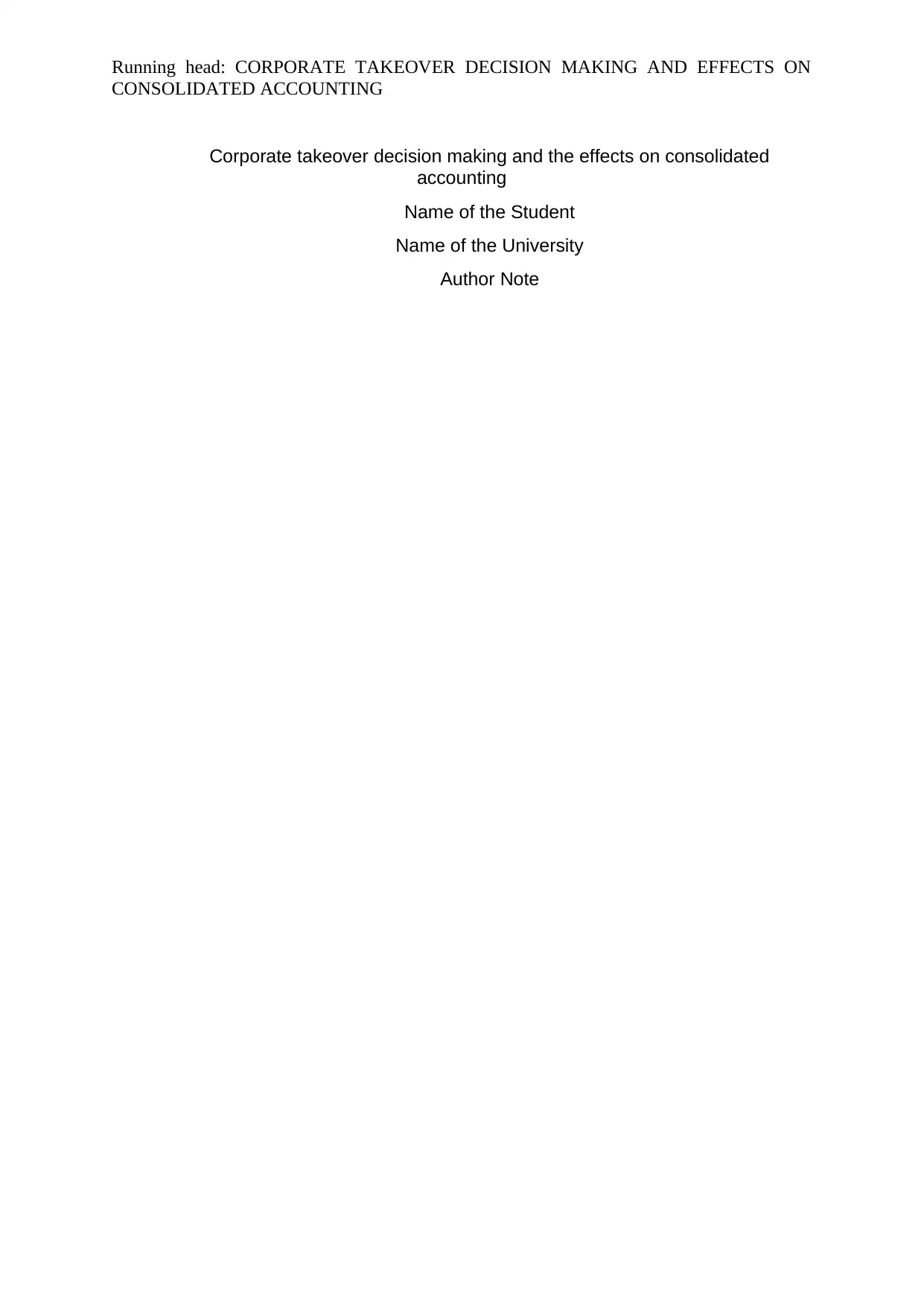
Running head: CORPORATE TAKEOVER DECISION MAKING AND EFFECTS ON
CONSOLIDATED ACCOUNTING
Corporate takeover decision making and the effects on consolidated
accounting
Name of the Student
Name of the University
Author Note
CONSOLIDATED ACCOUNTING
Corporate takeover decision making and the effects on consolidated
accounting
Name of the Student
Name of the University
Author Note
Paraphrase This Document
Need a fresh take? Get an instant paraphrase of this document with our AI Paraphraser
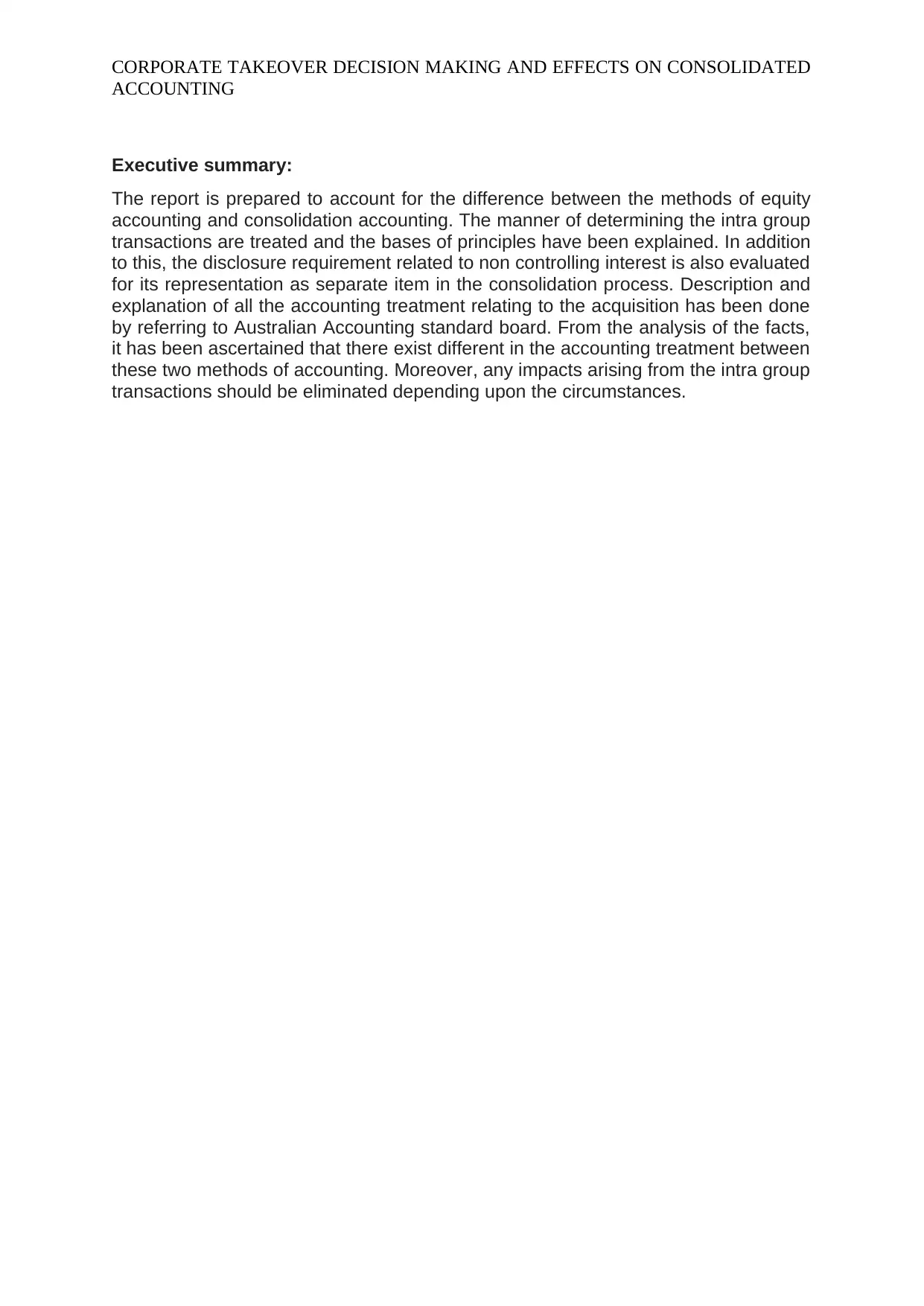
CORPORATE TAKEOVER DECISION MAKING AND EFFECTS ON CONSOLIDATED
ACCOUNTING
Executive summary:
The report is prepared to account for the difference between the methods of equity
accounting and consolidation accounting. The manner of determining the intra group
transactions are treated and the bases of principles have been explained. In addition
to this, the disclosure requirement related to non controlling interest is also evaluated
for its representation as separate item in the consolidation process. Description and
explanation of all the accounting treatment relating to the acquisition has been done
by referring to Australian Accounting standard board. From the analysis of the facts,
it has been ascertained that there exist different in the accounting treatment between
these two methods of accounting. Moreover, any impacts arising from the intra group
transactions should be eliminated depending upon the circumstances.
ACCOUNTING
Executive summary:
The report is prepared to account for the difference between the methods of equity
accounting and consolidation accounting. The manner of determining the intra group
transactions are treated and the bases of principles have been explained. In addition
to this, the disclosure requirement related to non controlling interest is also evaluated
for its representation as separate item in the consolidation process. Description and
explanation of all the accounting treatment relating to the acquisition has been done
by referring to Australian Accounting standard board. From the analysis of the facts,
it has been ascertained that there exist different in the accounting treatment between
these two methods of accounting. Moreover, any impacts arising from the intra group
transactions should be eliminated depending upon the circumstances.
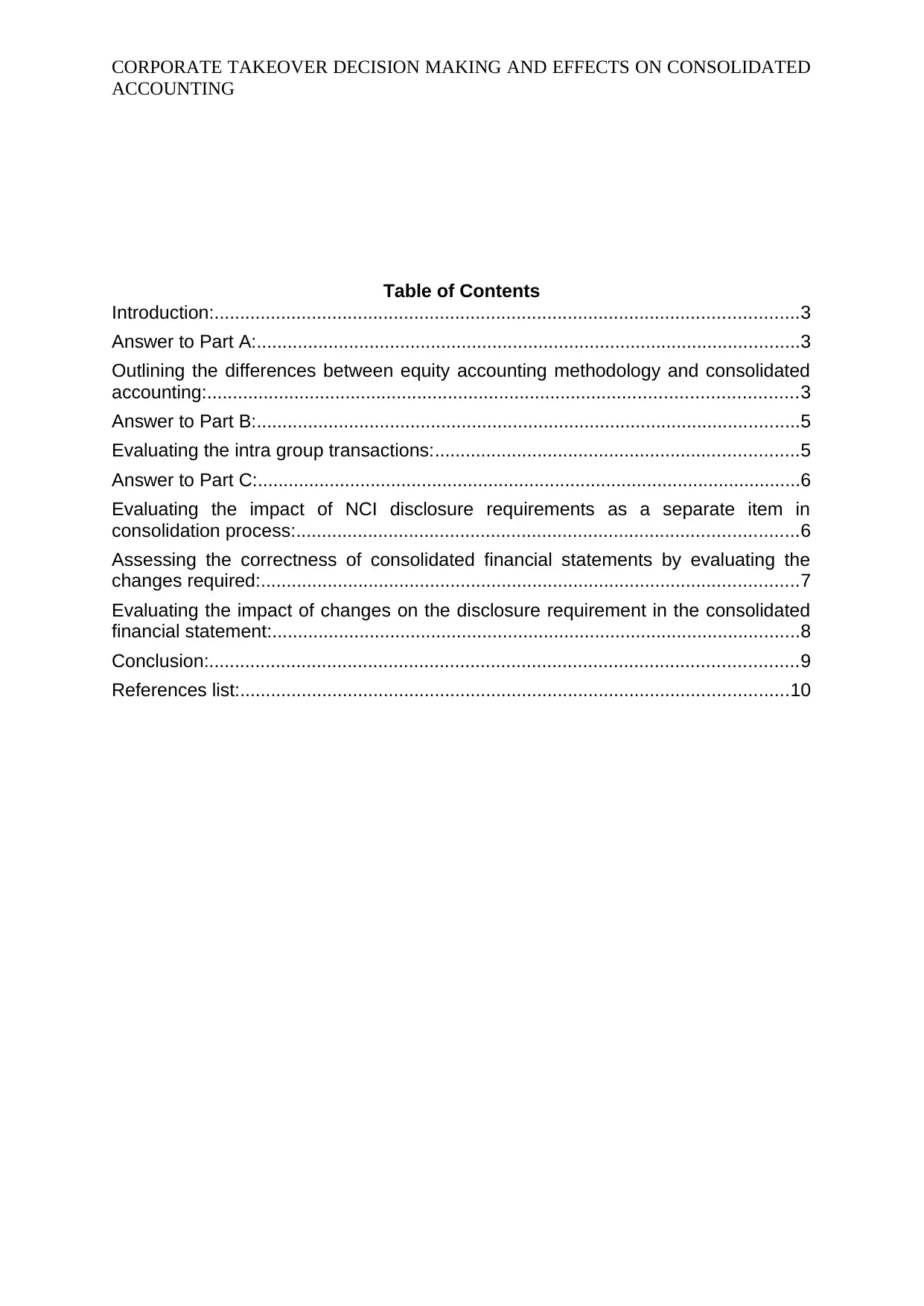
CORPORATE TAKEOVER DECISION MAKING AND EFFECTS ON CONSOLIDATED
ACCOUNTING
Table of Contents
Introduction:..................................................................................................................3
Answer to Part A:..........................................................................................................3
Outlining the differences between equity accounting methodology and consolidated
accounting:...................................................................................................................3
Answer to Part B:..........................................................................................................5
Evaluating the intra group transactions:.......................................................................5
Answer to Part C:..........................................................................................................6
Evaluating the impact of NCI disclosure requirements as a separate item in
consolidation process:..................................................................................................6
Assessing the correctness of consolidated financial statements by evaluating the
changes required:.........................................................................................................7
Evaluating the impact of changes on the disclosure requirement in the consolidated
financial statement:.......................................................................................................8
Conclusion:...................................................................................................................9
References list:...........................................................................................................10
ACCOUNTING
Table of Contents
Introduction:..................................................................................................................3
Answer to Part A:..........................................................................................................3
Outlining the differences between equity accounting methodology and consolidated
accounting:...................................................................................................................3
Answer to Part B:..........................................................................................................5
Evaluating the intra group transactions:.......................................................................5
Answer to Part C:..........................................................................................................6
Evaluating the impact of NCI disclosure requirements as a separate item in
consolidation process:..................................................................................................6
Assessing the correctness of consolidated financial statements by evaluating the
changes required:.........................................................................................................7
Evaluating the impact of changes on the disclosure requirement in the consolidated
financial statement:.......................................................................................................8
Conclusion:...................................................................................................................9
References list:...........................................................................................................10
⊘ This is a preview!⊘
Do you want full access?
Subscribe today to unlock all pages.

Trusted by 1+ million students worldwide
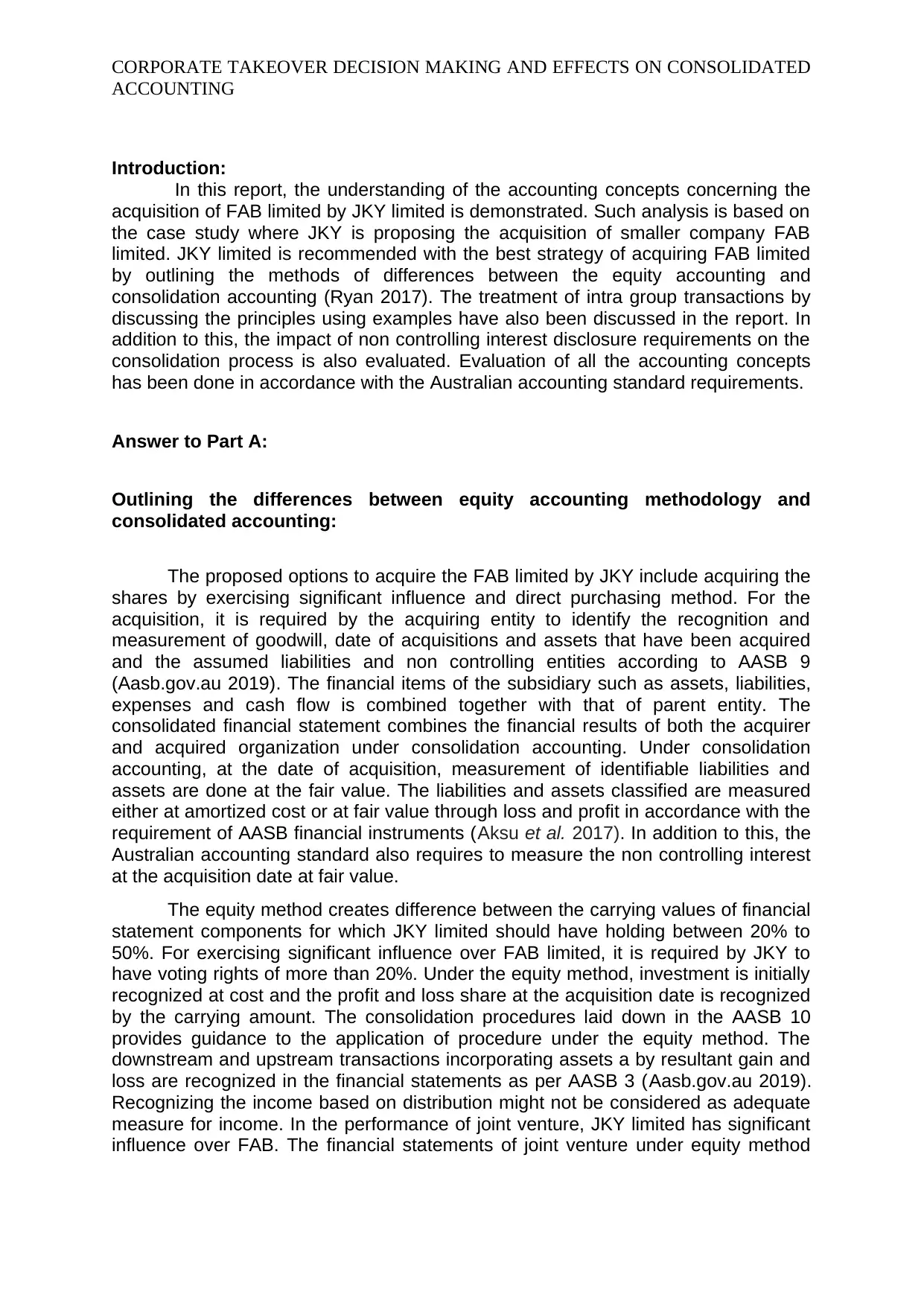
CORPORATE TAKEOVER DECISION MAKING AND EFFECTS ON CONSOLIDATED
ACCOUNTING
Introduction:
In this report, the understanding of the accounting concepts concerning the
acquisition of FAB limited by JKY limited is demonstrated. Such analysis is based on
the case study where JKY is proposing the acquisition of smaller company FAB
limited. JKY limited is recommended with the best strategy of acquiring FAB limited
by outlining the methods of differences between the equity accounting and
consolidation accounting (Ryan 2017). The treatment of intra group transactions by
discussing the principles using examples have also been discussed in the report. In
addition to this, the impact of non controlling interest disclosure requirements on the
consolidation process is also evaluated. Evaluation of all the accounting concepts
has been done in accordance with the Australian accounting standard requirements.
Answer to Part A:
Outlining the differences between equity accounting methodology and
consolidated accounting:
The proposed options to acquire the FAB limited by JKY include acquiring the
shares by exercising significant influence and direct purchasing method. For the
acquisition, it is required by the acquiring entity to identify the recognition and
measurement of goodwill, date of acquisitions and assets that have been acquired
and the assumed liabilities and non controlling entities according to AASB 9
(Aasb.gov.au 2019). The financial items of the subsidiary such as assets, liabilities,
expenses and cash flow is combined together with that of parent entity. The
consolidated financial statement combines the financial results of both the acquirer
and acquired organization under consolidation accounting. Under consolidation
accounting, at the date of acquisition, measurement of identifiable liabilities and
assets are done at the fair value. The liabilities and assets classified are measured
either at amortized cost or at fair value through loss and profit in accordance with the
requirement of AASB financial instruments (Aksu et al. 2017). In addition to this, the
Australian accounting standard also requires to measure the non controlling interest
at the acquisition date at fair value.
The equity method creates difference between the carrying values of financial
statement components for which JKY limited should have holding between 20% to
50%. For exercising significant influence over FAB limited, it is required by JKY to
have voting rights of more than 20%. Under the equity method, investment is initially
recognized at cost and the profit and loss share at the acquisition date is recognized
by the carrying amount. The consolidation procedures laid down in the AASB 10
provides guidance to the application of procedure under the equity method. The
downstream and upstream transactions incorporating assets a by resultant gain and
loss are recognized in the financial statements as per AASB 3 (Aasb.gov.au 2019).
Recognizing the income based on distribution might not be considered as adequate
measure for income. In the performance of joint venture, JKY limited has significant
influence over FAB. The financial statements of joint venture under equity method
ACCOUNTING
Introduction:
In this report, the understanding of the accounting concepts concerning the
acquisition of FAB limited by JKY limited is demonstrated. Such analysis is based on
the case study where JKY is proposing the acquisition of smaller company FAB
limited. JKY limited is recommended with the best strategy of acquiring FAB limited
by outlining the methods of differences between the equity accounting and
consolidation accounting (Ryan 2017). The treatment of intra group transactions by
discussing the principles using examples have also been discussed in the report. In
addition to this, the impact of non controlling interest disclosure requirements on the
consolidation process is also evaluated. Evaluation of all the accounting concepts
has been done in accordance with the Australian accounting standard requirements.
Answer to Part A:
Outlining the differences between equity accounting methodology and
consolidated accounting:
The proposed options to acquire the FAB limited by JKY include acquiring the
shares by exercising significant influence and direct purchasing method. For the
acquisition, it is required by the acquiring entity to identify the recognition and
measurement of goodwill, date of acquisitions and assets that have been acquired
and the assumed liabilities and non controlling entities according to AASB 9
(Aasb.gov.au 2019). The financial items of the subsidiary such as assets, liabilities,
expenses and cash flow is combined together with that of parent entity. The
consolidated financial statement combines the financial results of both the acquirer
and acquired organization under consolidation accounting. Under consolidation
accounting, at the date of acquisition, measurement of identifiable liabilities and
assets are done at the fair value. The liabilities and assets classified are measured
either at amortized cost or at fair value through loss and profit in accordance with the
requirement of AASB financial instruments (Aksu et al. 2017). In addition to this, the
Australian accounting standard also requires to measure the non controlling interest
at the acquisition date at fair value.
The equity method creates difference between the carrying values of financial
statement components for which JKY limited should have holding between 20% to
50%. For exercising significant influence over FAB limited, it is required by JKY to
have voting rights of more than 20%. Under the equity method, investment is initially
recognized at cost and the profit and loss share at the acquisition date is recognized
by the carrying amount. The consolidation procedures laid down in the AASB 10
provides guidance to the application of procedure under the equity method. The
downstream and upstream transactions incorporating assets a by resultant gain and
loss are recognized in the financial statements as per AASB 3 (Aasb.gov.au 2019).
Recognizing the income based on distribution might not be considered as adequate
measure for income. In the performance of joint venture, JKY limited has significant
influence over FAB. The financial statements of joint venture under equity method
Paraphrase This Document
Need a fresh take? Get an instant paraphrase of this document with our AI Paraphraser

CORPORATE TAKEOVER DECISION MAKING AND EFFECTS ON CONSOLIDATED
ACCOUNTING
are prepared by making adjustments by accounting for all the transactions at the
date when the combined entity was formed (Pereira et al. 2015)
Suppose, all the 50000 equity shares issued by FAB limited are acquired by
FAB limited on 31st December, 2018. Under the acquisition method, when JKY
limited owned 100% subsidiary in FAB limited would account for all the transactions.
It would be required by JKY limited under business combination to prepare
consolidated financial statements.
Answer to Part B:
Evaluating the intra group transactions:
There is a complete elimination of intra group transactions along with the
income, balances and expenses according to the requirement of accounting
standard AASB 127 (Aasb.gov.au 2019). Under the concept of single entity, all the
intra group assets and liabilities should be eliminated completely by the parent entity
along with income, cash flow and expenses in full. In addition to this, there is a
complete elimination of profits and loss recognized in the valuation of the inventories
and fixed assets arising from the intra group transactions. Unless, the cost can be
recovered, the amount of loss attributable from the intra group transaction should be
completely eliminated. The unrealized cost that is incurred in determining the
carrying value in the intra group transactions are eliminated completely unless there
is a complete elimination of the cost. The impact on the intra group losses, effects on
taxation and classification created due to the intra group transactions should also be
eliminated (Francioli and Albanese 2017).
This can be explained with the help of numerical example. Suppose, an item
of property is acquired by the parent company at a cost of $ 200 million and
assumption that the residual value is zero and estimated economic life of the assets
is 15 years. At the date of acquisition, the carrying value of assets is $ 180 million
with the accumulated depreciation at value of $ 80 million. Suppose that the cost of
property is recorded at $ 160 million and the property being sold at a loss of $ 20
million. Therefore, such loss is arising from intra group transaction should be
eliminated by considering that whether the adjustable carrying value is lower than
the assets recoverable amount.
In the given case, if the selling of inventories and providing professional
services by FAB limited generates profit and such amount should be deducted from
the total profits that is reported by subsidiary company.
The proportion of equity ownership that is not attributable directly or indirectly
to the parent company is the non controlling interest. It is essential to identify the non
controlling interest when the single entity after acquisition presents the financial
information. Non controlling interest is determined on the basis of present ownership
of interest when the allocation of profit and loss and change in proportion of equity
ownership is done to the parent company (Issakova et al. 2018).
The proportion of profit and loss that would be allocated to the parent entity
and non controlling interest accounting for investment under the equity method is
done solely on the basis of the current interest ownership according to the
ACCOUNTING
are prepared by making adjustments by accounting for all the transactions at the
date when the combined entity was formed (Pereira et al. 2015)
Suppose, all the 50000 equity shares issued by FAB limited are acquired by
FAB limited on 31st December, 2018. Under the acquisition method, when JKY
limited owned 100% subsidiary in FAB limited would account for all the transactions.
It would be required by JKY limited under business combination to prepare
consolidated financial statements.
Answer to Part B:
Evaluating the intra group transactions:
There is a complete elimination of intra group transactions along with the
income, balances and expenses according to the requirement of accounting
standard AASB 127 (Aasb.gov.au 2019). Under the concept of single entity, all the
intra group assets and liabilities should be eliminated completely by the parent entity
along with income, cash flow and expenses in full. In addition to this, there is a
complete elimination of profits and loss recognized in the valuation of the inventories
and fixed assets arising from the intra group transactions. Unless, the cost can be
recovered, the amount of loss attributable from the intra group transaction should be
completely eliminated. The unrealized cost that is incurred in determining the
carrying value in the intra group transactions are eliminated completely unless there
is a complete elimination of the cost. The impact on the intra group losses, effects on
taxation and classification created due to the intra group transactions should also be
eliminated (Francioli and Albanese 2017).
This can be explained with the help of numerical example. Suppose, an item
of property is acquired by the parent company at a cost of $ 200 million and
assumption that the residual value is zero and estimated economic life of the assets
is 15 years. At the date of acquisition, the carrying value of assets is $ 180 million
with the accumulated depreciation at value of $ 80 million. Suppose that the cost of
property is recorded at $ 160 million and the property being sold at a loss of $ 20
million. Therefore, such loss is arising from intra group transaction should be
eliminated by considering that whether the adjustable carrying value is lower than
the assets recoverable amount.
In the given case, if the selling of inventories and providing professional
services by FAB limited generates profit and such amount should be deducted from
the total profits that is reported by subsidiary company.
The proportion of equity ownership that is not attributable directly or indirectly
to the parent company is the non controlling interest. It is essential to identify the non
controlling interest when the single entity after acquisition presents the financial
information. Non controlling interest is determined on the basis of present ownership
of interest when the allocation of profit and loss and change in proportion of equity
ownership is done to the parent company (Issakova et al. 2018).
The proportion of profit and loss that would be allocated to the parent entity
and non controlling interest accounting for investment under the equity method is
done solely on the basis of the current interest ownership according to the
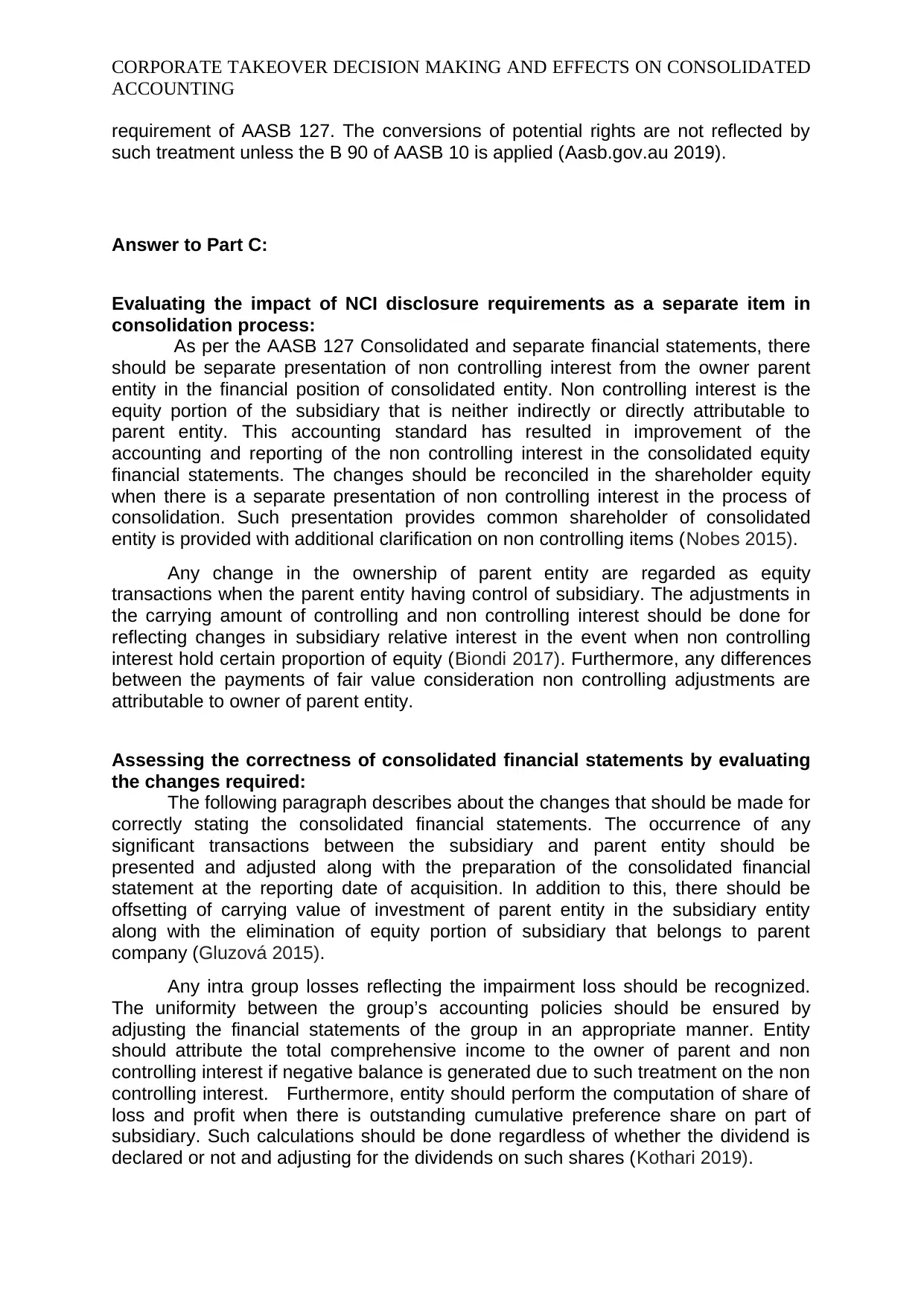
CORPORATE TAKEOVER DECISION MAKING AND EFFECTS ON CONSOLIDATED
ACCOUNTING
requirement of AASB 127. The conversions of potential rights are not reflected by
such treatment unless the B 90 of AASB 10 is applied (Aasb.gov.au 2019).
Answer to Part C:
Evaluating the impact of NCI disclosure requirements as a separate item in
consolidation process:
As per the AASB 127 Consolidated and separate financial statements, there
should be separate presentation of non controlling interest from the owner parent
entity in the financial position of consolidated entity. Non controlling interest is the
equity portion of the subsidiary that is neither indirectly or directly attributable to
parent entity. This accounting standard has resulted in improvement of the
accounting and reporting of the non controlling interest in the consolidated equity
financial statements. The changes should be reconciled in the shareholder equity
when there is a separate presentation of non controlling interest in the process of
consolidation. Such presentation provides common shareholder of consolidated
entity is provided with additional clarification on non controlling items (Nobes 2015).
Any change in the ownership of parent entity are regarded as equity
transactions when the parent entity having control of subsidiary. The adjustments in
the carrying amount of controlling and non controlling interest should be done for
reflecting changes in subsidiary relative interest in the event when non controlling
interest hold certain proportion of equity (Biondi 2017). Furthermore, any differences
between the payments of fair value consideration non controlling adjustments are
attributable to owner of parent entity.
Assessing the correctness of consolidated financial statements by evaluating
the changes required:
The following paragraph describes about the changes that should be made for
correctly stating the consolidated financial statements. The occurrence of any
significant transactions between the subsidiary and parent entity should be
presented and adjusted along with the preparation of the consolidated financial
statement at the reporting date of acquisition. In addition to this, there should be
offsetting of carrying value of investment of parent entity in the subsidiary entity
along with the elimination of equity portion of subsidiary that belongs to parent
company (Gluzová 2015).
Any intra group losses reflecting the impairment loss should be recognized.
The uniformity between the group’s accounting policies should be ensured by
adjusting the financial statements of the group in an appropriate manner. Entity
should attribute the total comprehensive income to the owner of parent and non
controlling interest if negative balance is generated due to such treatment on the non
controlling interest. Furthermore, entity should perform the computation of share of
loss and profit when there is outstanding cumulative preference share on part of
subsidiary. Such calculations should be done regardless of whether the dividend is
declared or not and adjusting for the dividends on such shares (Kothari 2019).
ACCOUNTING
requirement of AASB 127. The conversions of potential rights are not reflected by
such treatment unless the B 90 of AASB 10 is applied (Aasb.gov.au 2019).
Answer to Part C:
Evaluating the impact of NCI disclosure requirements as a separate item in
consolidation process:
As per the AASB 127 Consolidated and separate financial statements, there
should be separate presentation of non controlling interest from the owner parent
entity in the financial position of consolidated entity. Non controlling interest is the
equity portion of the subsidiary that is neither indirectly or directly attributable to
parent entity. This accounting standard has resulted in improvement of the
accounting and reporting of the non controlling interest in the consolidated equity
financial statements. The changes should be reconciled in the shareholder equity
when there is a separate presentation of non controlling interest in the process of
consolidation. Such presentation provides common shareholder of consolidated
entity is provided with additional clarification on non controlling items (Nobes 2015).
Any change in the ownership of parent entity are regarded as equity
transactions when the parent entity having control of subsidiary. The adjustments in
the carrying amount of controlling and non controlling interest should be done for
reflecting changes in subsidiary relative interest in the event when non controlling
interest hold certain proportion of equity (Biondi 2017). Furthermore, any differences
between the payments of fair value consideration non controlling adjustments are
attributable to owner of parent entity.
Assessing the correctness of consolidated financial statements by evaluating
the changes required:
The following paragraph describes about the changes that should be made for
correctly stating the consolidated financial statements. The occurrence of any
significant transactions between the subsidiary and parent entity should be
presented and adjusted along with the preparation of the consolidated financial
statement at the reporting date of acquisition. In addition to this, there should be
offsetting of carrying value of investment of parent entity in the subsidiary entity
along with the elimination of equity portion of subsidiary that belongs to parent
company (Gluzová 2015).
Any intra group losses reflecting the impairment loss should be recognized.
The uniformity between the group’s accounting policies should be ensured by
adjusting the financial statements of the group in an appropriate manner. Entity
should attribute the total comprehensive income to the owner of parent and non
controlling interest if negative balance is generated due to such treatment on the non
controlling interest. Furthermore, entity should perform the computation of share of
loss and profit when there is outstanding cumulative preference share on part of
subsidiary. Such calculations should be done regardless of whether the dividend is
declared or not and adjusting for the dividends on such shares (Kothari 2019).
⊘ This is a preview!⊘
Do you want full access?
Subscribe today to unlock all pages.

Trusted by 1+ million students worldwide

CORPORATE TAKEOVER DECISION MAKING AND EFFECTS ON CONSOLIDATED
ACCOUNTING
Evaluating the impact of changes on the disclosure requirement in the
consolidated financial statement:
According to the paragraph 10 of AASB 127 of the consolidated financial
statements, there is relaxation on the preparation of consolidated financial
statements. Entity is not required to provide any specific disclosure when there is not
existence of materiality. There should be disclosure about the measurement basis
and significant accounting policies. The nature and extent of significant restrictions
resulting from the regulations that requires the subsidiary entity to transfer any cash
dividends, repayment of loans and advances made to the parent company
(Aasb.gov.au 2019). The financial statements of the subsidiary at the end of
reporting period should be disclosed when preparing the consolidated financial
statement along with disclosing the reason for difference between the dates of
reporting by providing proper explanation. Moreover, the nature of relationship
between parent and subsidiary should be disclosed when more than half of the
voting power is not owned by parent company either directly or indirectly (Garcia et
al. 2018). Therefore, it can be inferred that in the event of preparing the financial
statements, the disclosure requirements are considerably affected.
Conclusion:
The accounting treatment of equity method and direct purchasing has
significant difference which has been deduced from the facts that is addressed
regarding the consolidation accounting. In addition to this, there also exist some
difference between the principles of measurement and recognition by outlining the
difference between those two methods. The consolidated financial statements of the
entity prepared after acquisition accounts for difference between intra group
transactions treatment. It has also been ascertained that the process of consolidation
is impacted by the disclosure requirements associated with the non controlling
interest.
ACCOUNTING
Evaluating the impact of changes on the disclosure requirement in the
consolidated financial statement:
According to the paragraph 10 of AASB 127 of the consolidated financial
statements, there is relaxation on the preparation of consolidated financial
statements. Entity is not required to provide any specific disclosure when there is not
existence of materiality. There should be disclosure about the measurement basis
and significant accounting policies. The nature and extent of significant restrictions
resulting from the regulations that requires the subsidiary entity to transfer any cash
dividends, repayment of loans and advances made to the parent company
(Aasb.gov.au 2019). The financial statements of the subsidiary at the end of
reporting period should be disclosed when preparing the consolidated financial
statement along with disclosing the reason for difference between the dates of
reporting by providing proper explanation. Moreover, the nature of relationship
between parent and subsidiary should be disclosed when more than half of the
voting power is not owned by parent company either directly or indirectly (Garcia et
al. 2018). Therefore, it can be inferred that in the event of preparing the financial
statements, the disclosure requirements are considerably affected.
Conclusion:
The accounting treatment of equity method and direct purchasing has
significant difference which has been deduced from the facts that is addressed
regarding the consolidation accounting. In addition to this, there also exist some
difference between the principles of measurement and recognition by outlining the
difference between those two methods. The consolidated financial statements of the
entity prepared after acquisition accounts for difference between intra group
transactions treatment. It has also been ascertained that the process of consolidation
is impacted by the disclosure requirements associated with the non controlling
interest.
Paraphrase This Document
Need a fresh take? Get an instant paraphrase of this document with our AI Paraphraser
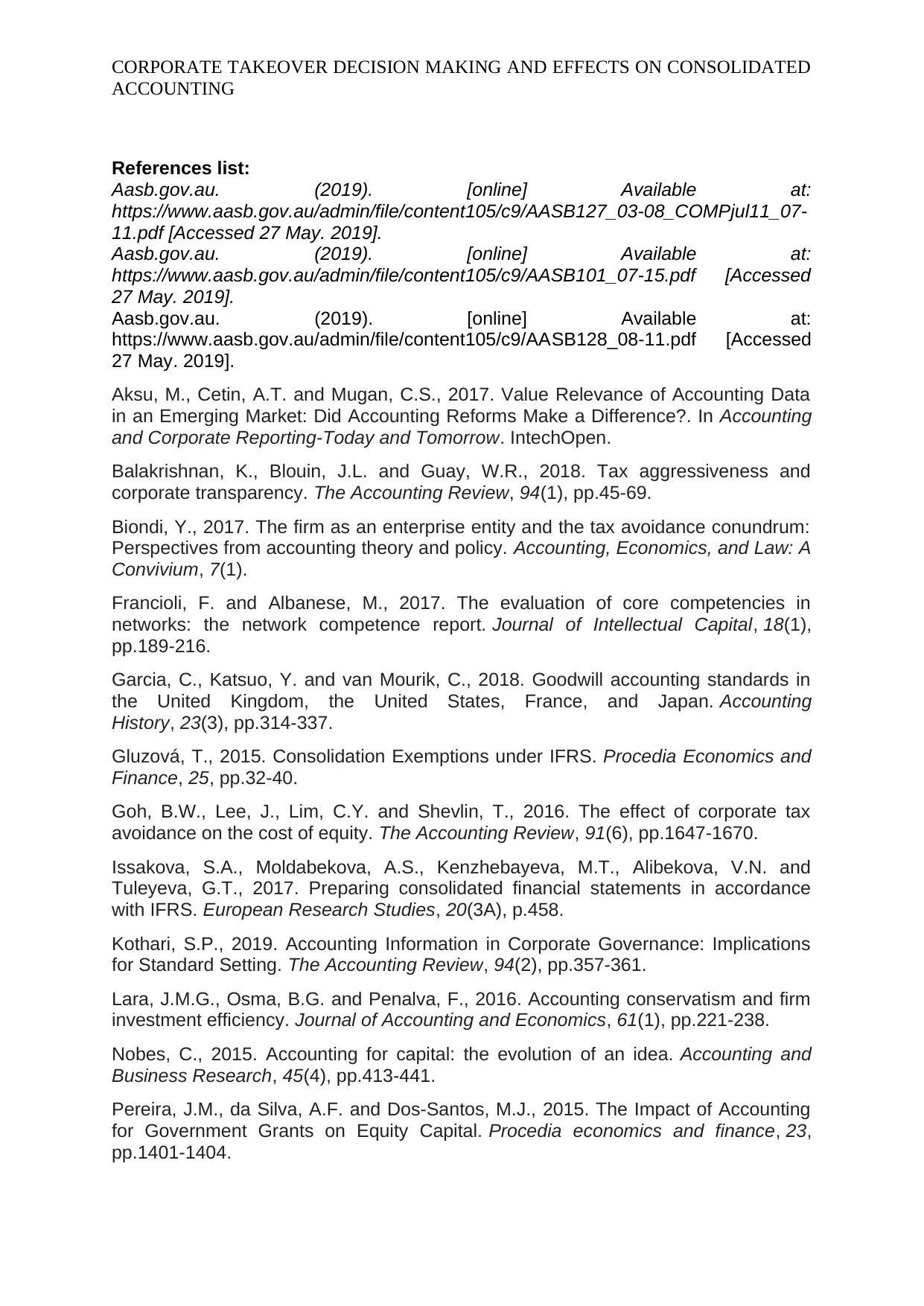
CORPORATE TAKEOVER DECISION MAKING AND EFFECTS ON CONSOLIDATED
ACCOUNTING
References list:
Aasb.gov.au. (2019). [online] Available at:
https://www.aasb.gov.au/admin/file/content105/c9/AASB127_03-08_COMPjul11_07-
11.pdf [Accessed 27 May. 2019].
Aasb.gov.au. (2019). [online] Available at:
https://www.aasb.gov.au/admin/file/content105/c9/AASB101_07-15.pdf [Accessed
27 May. 2019].
Aasb.gov.au. (2019). [online] Available at:
https://www.aasb.gov.au/admin/file/content105/c9/AASB128_08-11.pdf [Accessed
27 May. 2019].
Aksu, M., Cetin, A.T. and Mugan, C.S., 2017. Value Relevance of Accounting Data
in an Emerging Market: Did Accounting Reforms Make a Difference?. In Accounting
and Corporate Reporting-Today and Tomorrow. IntechOpen.
Balakrishnan, K., Blouin, J.L. and Guay, W.R., 2018. Tax aggressiveness and
corporate transparency. The Accounting Review, 94(1), pp.45-69.
Biondi, Y., 2017. The firm as an enterprise entity and the tax avoidance conundrum:
Perspectives from accounting theory and policy. Accounting, Economics, and Law: A
Convivium, 7(1).
Francioli, F. and Albanese, M., 2017. The evaluation of core competencies in
networks: the network competence report. Journal of Intellectual Capital, 18(1),
pp.189-216.
Garcia, C., Katsuo, Y. and van Mourik, C., 2018. Goodwill accounting standards in
the United Kingdom, the United States, France, and Japan. Accounting
History, 23(3), pp.314-337.
Gluzová, T., 2015. Consolidation Exemptions under IFRS. Procedia Economics and
Finance, 25, pp.32-40.
Goh, B.W., Lee, J., Lim, C.Y. and Shevlin, T., 2016. The effect of corporate tax
avoidance on the cost of equity. The Accounting Review, 91(6), pp.1647-1670.
Issakova, S.A., Moldabekova, A.S., Kenzhebayeva, M.T., Alibekova, V.N. and
Tuleyeva, G.T., 2017. Preparing consolidated financial statements in accordance
with IFRS. European Research Studies, 20(3A), p.458.
Kothari, S.P., 2019. Accounting Information in Corporate Governance: Implications
for Standard Setting. The Accounting Review, 94(2), pp.357-361.
Lara, J.M.G., Osma, B.G. and Penalva, F., 2016. Accounting conservatism and firm
investment efficiency. Journal of Accounting and Economics, 61(1), pp.221-238.
Nobes, C., 2015. Accounting for capital: the evolution of an idea. Accounting and
Business Research, 45(4), pp.413-441.
Pereira, J.M., da Silva, A.F. and Dos-Santos, M.J., 2015. The Impact of Accounting
for Government Grants on Equity Capital. Procedia economics and finance, 23,
pp.1401-1404.
ACCOUNTING
References list:
Aasb.gov.au. (2019). [online] Available at:
https://www.aasb.gov.au/admin/file/content105/c9/AASB127_03-08_COMPjul11_07-
11.pdf [Accessed 27 May. 2019].
Aasb.gov.au. (2019). [online] Available at:
https://www.aasb.gov.au/admin/file/content105/c9/AASB101_07-15.pdf [Accessed
27 May. 2019].
Aasb.gov.au. (2019). [online] Available at:
https://www.aasb.gov.au/admin/file/content105/c9/AASB128_08-11.pdf [Accessed
27 May. 2019].
Aksu, M., Cetin, A.T. and Mugan, C.S., 2017. Value Relevance of Accounting Data
in an Emerging Market: Did Accounting Reforms Make a Difference?. In Accounting
and Corporate Reporting-Today and Tomorrow. IntechOpen.
Balakrishnan, K., Blouin, J.L. and Guay, W.R., 2018. Tax aggressiveness and
corporate transparency. The Accounting Review, 94(1), pp.45-69.
Biondi, Y., 2017. The firm as an enterprise entity and the tax avoidance conundrum:
Perspectives from accounting theory and policy. Accounting, Economics, and Law: A
Convivium, 7(1).
Francioli, F. and Albanese, M., 2017. The evaluation of core competencies in
networks: the network competence report. Journal of Intellectual Capital, 18(1),
pp.189-216.
Garcia, C., Katsuo, Y. and van Mourik, C., 2018. Goodwill accounting standards in
the United Kingdom, the United States, France, and Japan. Accounting
History, 23(3), pp.314-337.
Gluzová, T., 2015. Consolidation Exemptions under IFRS. Procedia Economics and
Finance, 25, pp.32-40.
Goh, B.W., Lee, J., Lim, C.Y. and Shevlin, T., 2016. The effect of corporate tax
avoidance on the cost of equity. The Accounting Review, 91(6), pp.1647-1670.
Issakova, S.A., Moldabekova, A.S., Kenzhebayeva, M.T., Alibekova, V.N. and
Tuleyeva, G.T., 2017. Preparing consolidated financial statements in accordance
with IFRS. European Research Studies, 20(3A), p.458.
Kothari, S.P., 2019. Accounting Information in Corporate Governance: Implications
for Standard Setting. The Accounting Review, 94(2), pp.357-361.
Lara, J.M.G., Osma, B.G. and Penalva, F., 2016. Accounting conservatism and firm
investment efficiency. Journal of Accounting and Economics, 61(1), pp.221-238.
Nobes, C., 2015. Accounting for capital: the evolution of an idea. Accounting and
Business Research, 45(4), pp.413-441.
Pereira, J.M., da Silva, A.F. and Dos-Santos, M.J., 2015. The Impact of Accounting
for Government Grants on Equity Capital. Procedia economics and finance, 23,
pp.1401-1404.
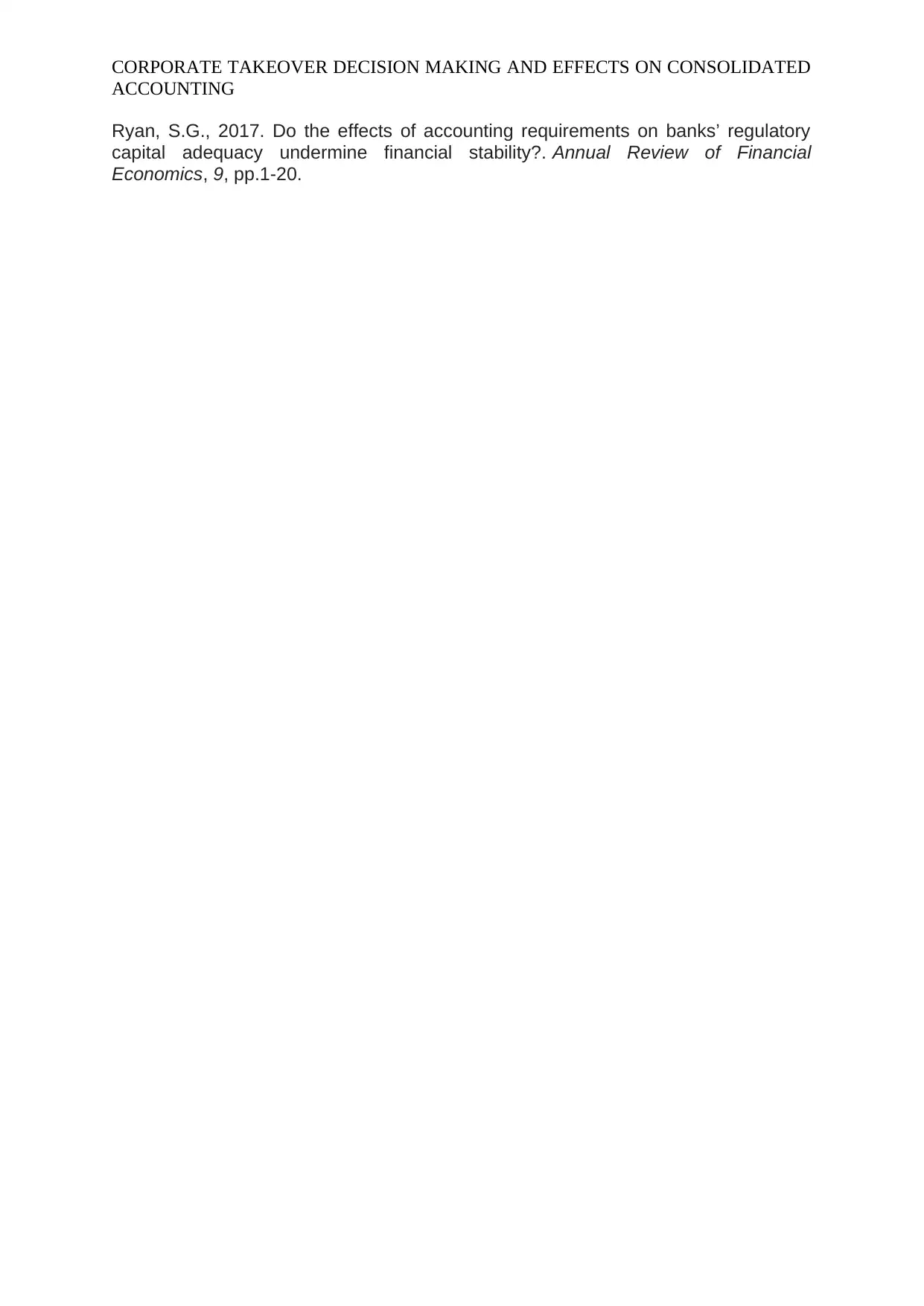
CORPORATE TAKEOVER DECISION MAKING AND EFFECTS ON CONSOLIDATED
ACCOUNTING
Ryan, S.G., 2017. Do the effects of accounting requirements on banks’ regulatory
capital adequacy undermine financial stability?. Annual Review of Financial
Economics, 9, pp.1-20.
ACCOUNTING
Ryan, S.G., 2017. Do the effects of accounting requirements on banks’ regulatory
capital adequacy undermine financial stability?. Annual Review of Financial
Economics, 9, pp.1-20.
⊘ This is a preview!⊘
Do you want full access?
Subscribe today to unlock all pages.

Trusted by 1+ million students worldwide
1 out of 9
Related Documents
Your All-in-One AI-Powered Toolkit for Academic Success.
+13062052269
info@desklib.com
Available 24*7 on WhatsApp / Email
![[object Object]](/_next/static/media/star-bottom.7253800d.svg)
Unlock your academic potential
Copyright © 2020–2025 A2Z Services. All Rights Reserved. Developed and managed by ZUCOL.





